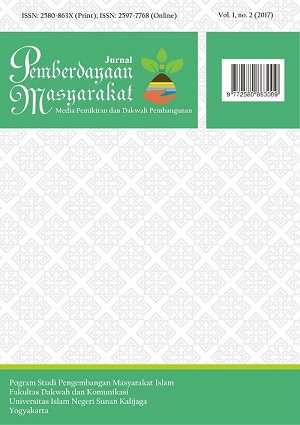Pesona Kearifan Lokal Sebagai Wahana Peningkatan Produktifitas Ekonomi Masyarakat
DOI:
https://doi.org/10.14421/jpm.2017.012-05Keywords:
participation, tourism, destinantion management organitation.Abstract
This article is about to review related to the form of management, public participation, and the impact of management of tourism potential in Pangandaran beach. This is based on the reason that Pangandaran beach has the potential of exotic tourism that is supported by other nature tourism. The method used in this study is descriptive qualitative. Sources of research data include the community of West Pangandaran Country, a government of Pangandaran Country, Tourism Office of Pangandaran Regional, and investors. The location of this research is West Citizens Association (Rukun Warga-RW) Pangandaran, Pangandaran Country, West Java. The method used in data collection in this research is by observation, documentation, and interview. The data obtained in this study were analyzed by reduced and presented in descriptive data display, then drawn a conclusion. The method used to obtain the validity of data using triangulation of sources, theories, and methods. In the management of this tourism potential, Pangandaran beach has a form of community-based tourism management or Community-Based Tourism (CBT). Where this form of management put forward the concept of harmony between stakeholders, i.e. community, government and private (investors). However, in the management of this community-based tourism, the role of local people is prioritized, because the main objective is the welfare of the local community through economic improvement by utilizing the existing potential. This community engagement process is so long that it creates the ideal form of CBT management.
Artikel ini hendak mengkaji terkait dengan bentuk pengelolaan, partisipasi masyarakat, dan dampak pengelolaan potensi pariwisata di Pantai Pangandaran. Hal ini dilandasi dengan alasan bahwa Pantai Pangandaran memililki potensi pariwisata eksotik yang diitunjang dengan wisata alam lainnya. Adapun metode yang digunakan dalam kajian ini bersifat deskriptif-kualitatif. Sumber data penelitian meliputi masyarakat Dusun Pangandaran Barat, pemerintah Desa Pangandaran, Dinas Pariwisata Kab. Pangandaran, dan para investor. Lokasi penelitian ini adalah Dusun Pangandaran Barat, Desa Pangandaran, Jawa Barat. Metode yang digunakan dalam pengeumpulan data pada penelitian ini, yaitu dengan observasi, dokumentasi, dan wawancara. Data yang diperoleh dalam penelitian ini dianalisis dengan direduksi dan disajikan dalam display data deskriptif, kemudian ditarik kesimpulan. Metode yang digunakan untuk memperoleh keabsahan data menggunakan triangulasi sumber, teori dan metode. Dalam pengelolaan potensi pariwisata ini, pantai Pangandaran mempunyai bentuk pengelolaan pariwisata berbasis masyarakat atau Community Based Tourism (CBT). Di mana bentuk pengelolaan ini mengedepankan konsep keselarasan antara para stakeholder, yaitu masyarakat, pemerintah dan swasta (investor). Namun dalam pengelolaan pariwisata berbasis masyarakat ini, peran masyarakat lokal lebih dikedepankan, sebab tujuan utamanya adalah kesejahteraan masyarakat lokal melalui peningkatan ekonomi dengan memanfaatkan potensi yang ada. Proses pelibatan masyarakat ini sangat panjang sehingga menghasilkan bentuk pengelolaan CBT yang ideal.
 Abstract viewed: 1004 times
|
Abstract viewed: 1004 times
|
 PDF downloaded = 1328 times
PDF downloaded = 1328 times
References
[Internet] http:/www.pikiran-rakyat.com/node/310977. Diakses 4/03/2015.
[Internet], diunduh dalam www.disparbud.jabarprov.go.id/wisata/ dest-det.php?id=7&lang=. Diakses 18/09/2014.
Dewi, M. (2008). “Analisis Strategi Pemasaran pengelola Pariwisata Pantai Pangandaran Pasca Tsunami”. Bogor: Institut Pertanian Bogor.
Abdul, H. M. (2013). “Perancangan Sistem Informasi Pariwisata Kabupaten Kulon Progo Berbasis Android”. Yogyakarta: UIN Sunan Kalijaga.
Sakti, H. S. (2012). Perencanaan Pariwisata Perdesaan Berbasis Masyarakat. Yogyakarta: Graha Ilmu. Undang–undang Republik Indonesia No. 10 Tahun 2009 Tentang Kepariwisataan.
Downloads
Published
Issue
Section
License
Authors who publish with this journal agree to the following terms:
(1) The Author retains copyright in the Work, where the term “Work” shall include all digital objects that may result in subsequent electronic publication or distribution.(2) Upon acceptance of the Work, the author shall grant to the Publisher the right of first publication of the Work.
(3) The Author shall grant to the Publisher and its agents the nonexclusive perpetual right and license to publish, archive, and make accessible the Work in whole or in part in all forms of media now or hereafter known under a Attribution-Non Commercial 4.0 International (CC BY-NC 4.0) or its equivalent, which, for the avoidance of doubt, allows others to copy, distribute, and transmit the Work under the following conditions.
(4) The Author represents and warrants that:
- the Work is the Author’s original work;
- the Author has not transferred, and will not transfer, exclusive rights in the Work to any third party;
- the Work is not pending review or under consideration by another publisher;
- the Work has not previously been published;
- the Work contains no misrepresentation or infringement of the Work or property of other authors or third parties; and
- the Work contains no libel, invasion of privacy, or other unlawful matter.
Attribution—other users must attribute the Work in the manner specified by the author as indicated on the journal Web site.








